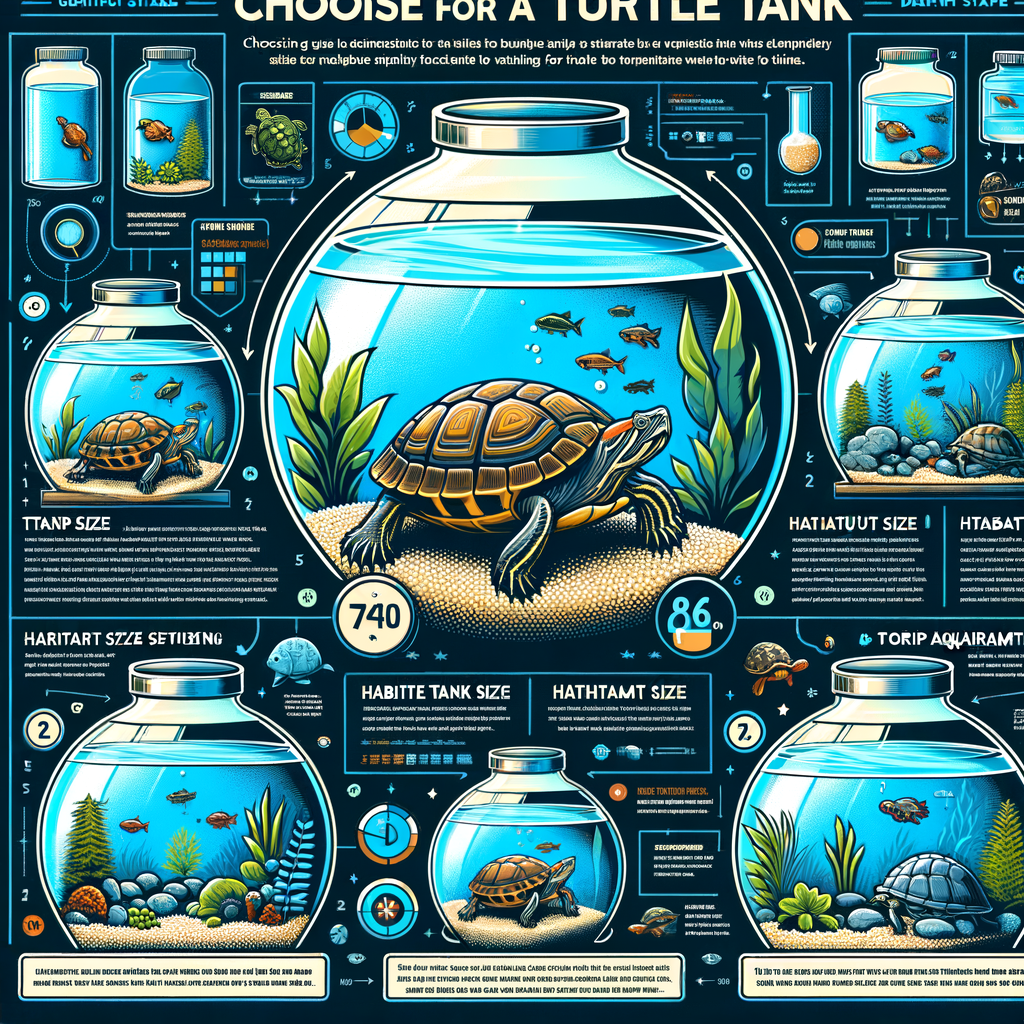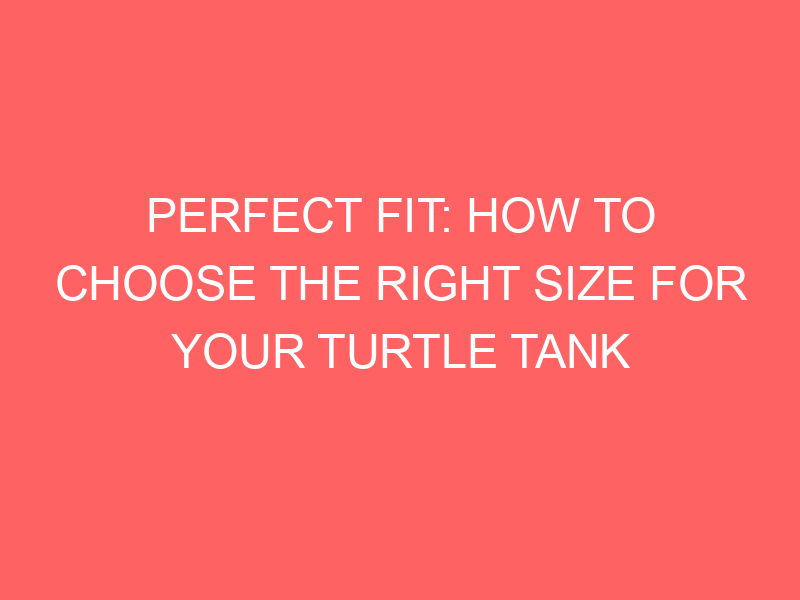
Introduction to Turtle Tank Sizes
When it comes to keeping turtles as pets, one of the most important aspects to consider is the size of their tank. This is not just about providing enough room for your turtle to move around, but also about ensuring their overall health and wellbeing. In this section, we will delve into the importance of choosing the right turtle tank size and its impact on your turtle’s health and wellbeing.
- Importance of choosing the right turtle tank size
- Impact of tank size on turtle’s health and wellbeing
Choosing the right size for your turtle’s tank is crucial for several reasons. First, turtles are active creatures that need plenty of space to swim, bask, and explore. A tank that is too small can limit their movement and lead to boredom and stress. Second, the size of the tank can affect the quality of the water. In a small tank, waste products can build up quickly, leading to poor water quality that can harm your turtle’s health. Therefore, it’s essential to choose a tank size that not only accommodates your turtle’s physical size but also its needs and behaviors.
The size of the tank can have a significant impact on your turtle’s health and wellbeing. A tank that is too small can lead to various health problems, including shell deformities, skin and shell infections, and respiratory issues. On the other hand, a tank that is too large can make it difficult for your turtle to find its food and basking spots, leading to malnutrition and stress. Therefore, it’s crucial to find a balance and choose a tank size that is just right for your turtle.
In the following sections, we will provide more detailed information on understanding turtle habitat size, choosing turtle tank dimensions, setting up an aquarium for turtles, and a guide to ideal turtle tank dimensions. Stay tuned to learn more about how to provide the best home for your turtle.
Understanding Turtle Habitat Size
When it comes to providing a suitable home for your pet turtle, size matters. The size of the turtle’s habitat can significantly impact its health and happiness. In this section, we will explore the size requirements for different turtle species.
Size Requirements for Different Turtle Species
Not all turtles are the same size, and neither should their habitats be. Different species of turtles have different size requirements. Let’s break down these requirements by small, medium, and large turtle species.
- Size requirements for small turtle species
- Size requirements for medium turtle species
- Size requirements for large turtle species
Small turtle species, such as the Spotted Turtle or the Musk Turtle, typically reach a length of 4 to 5 inches when fully grown. For these small species, a 20 to 30-gallon tank is usually sufficient. However, remember that more space is always better for your turtle’s overall well-being.
Medium turtle species like the Red-Eared Slider or the Painted Turtle can grow up to 10 inches in length. A habitat for these turtles should be at least 40 to 60 gallons. This size allows them enough room to swim, bask, and hide.
Large turtle species, such as the Common Snapping Turtle or the Alligator Snapping Turtle, can grow up to 18 inches or more. These turtles require a significantly larger habitat, typically 120 gallons or more. It’s important to provide them with ample space to move around and explore.
In conclusion, the size of your turtle’s habitat should reflect the size and needs of your turtle. Always remember that a larger habitat is generally better for your turtle’s health and happiness. Stay tuned for our next section where we will discuss how to choose the right tank dimensions for your turtle.
Choosing Turtle Tank Dimensions
When it comes to providing a comfortable and healthy environment for your pet turtle, choosing the right tank dimensions is crucial. This choice can significantly impact your turtle’s quality of life. Let’s dive into the factors you need to consider when selecting the perfect turtle tank dimensions.
Factors to Consider When Choosing Turtle Tank Dimensions
There are several important factors to consider when deciding on the size of your turtle tank. Here are the key ones:
- Size of the Turtle: The size of your turtle is the first factor to consider. As a rule of thumb, a turtle needs 10 gallons of water for every inch of its shell length. So, if your turtle’s shell is 5 inches long, you’ll need a tank that can hold at least 50 gallons of water.
- Number of Turtles: If you have more than one turtle, you’ll need to adjust the tank size accordingly. Each turtle should have its own space to swim and explore. Simply multiply the tank size needed for one turtle by the number of turtles you have.
- Available Space at Home: You also need to consider the space available at your home. Make sure you have enough room to place the tank in a safe and suitable location. Remember, the tank should be away from direct sunlight and heat sources.
- Future Growth of the Turtle: Turtles grow over time, and their space requirements increase as they do. It’s wise to plan for your turtle’s future growth when choosing a tank. This way, you won’t need to replace the tank as your turtle grows.
In conclusion, choosing the right turtle tank dimensions is a balance between your turtle’s needs and your home’s available space. By considering these factors, you can ensure your turtle has a comfortable and healthy environment to thrive in.
Setting Up an Aquarium for Turtles
Setting up an aquarium for turtles can seem like a daunting task, but with the right knowledge and tools, it can be a rewarding experience. Turtles are fascinating creatures that require specific conditions to thrive. This guide will walk you through the essential components of a turtle tank setup.
Essential Components of a Turtle Tank Setup
There are four key components to consider when setting up a turtle tank: the proper tank size, a water filtration system, heating and lighting, and a basking area. Each of these components plays a crucial role in maintaining a healthy environment for your turtle.
- Proper Turtle Tank Size
- Water Filtration System
- Heating and Lighting
- Basking Area
The size of your turtle tank should be determined by the size and species of your turtle. As a general rule, for every inch of turtle, you should provide 10 gallons of water. For example, a 5-inch turtle would require a 50-gallon tank. This ensures that your turtle has enough space to swim and explore.
A water filtration system is essential to keep the water in your turtle tank clean and free of harmful bacteria. There are various types of filters available, including canister filters and internal filters. The choice of filter will depend on the size of your tank and the specific needs of your turtle.
Turtles are cold-blooded animals, meaning they rely on their environment to regulate their body temperature. Therefore, it’s important to provide a heat source in your turtle tank. A submersible heater and a heat lamp are commonly used. Additionally, turtles need UVB light to synthesize vitamin D3, which is crucial for their shell and bone health.
A basking area is a dry place where your turtle can rest and soak up heat and UVB light. This can be achieved by placing a flat rock or a special turtle dock in the tank. The basking area should be large enough for your turtle to fully climb out of the water and dry off.
In conclusion, setting up a turtle tank requires careful planning and consideration. By providing the proper tank size, a water filtration system, appropriate heating and lighting, and a basking area, you can create a comfortable and healthy environment for your turtle.
Guide to Ideal Turtle Tank Dimensions
When it comes to creating a comfortable and healthy environment for your turtle, the size of the tank plays a crucial role. The tank dimensions should be suitable for the turtle’s size and species. Let’s explore some case studies that illustrate the ideal tank dimensions for different turtle species.
Case Studies: Examples of Ideal Turtle Tank Dimensions
These case studies will provide practical examples of the ideal tank dimensions for small, medium, and large turtle species. Each case study will highlight the species, their average size, and the recommended tank dimensions.
- Case study 1: Small turtle species
- Case study 2: Medium turtle species
- Case study 3: Large turtle species
Consider the Musk Turtle, a small species that grows up to 5 inches. For this turtle, a tank of 20 gallons is suitable. The tank should be 24 inches long, 12 inches wide, and 16 inches high. This allows the turtle enough space to swim and bask comfortably.
Let’s take the example of the Red-Eared Slider, a medium-sized turtle that can grow up to 12 inches. For this species, a 75-gallon tank is recommended. The ideal dimensions would be 48 inches long, 18 inches wide, and 21 inches high. This provides ample space for swimming and basking.
The Common Snapping Turtle, a large species that can grow up to 20 inches, requires a much larger tank. A 125-gallon tank is ideal, with dimensions of 72 inches long, 18 inches wide, and 23 inches high. This offers the turtle plenty of room to move around and engage in natural behaviors.
Remember, these are just guidelines. The actual tank size may vary depending on the turtle’s individual needs and behavior. Always monitor your turtle’s behavior to ensure it is comfortable and healthy in its environment.
Key Takeaways: Sizing Turtle Tanks
As we wrap up our discussion on turtle tank sizes, it’s important to remember a few key points. These takeaways will help you make the right decisions when setting up a turtle tank, ensuring your pet turtle has a comfortable and healthy environment to live in.
- Importance of Proper Turtle Tank Size
- Factors to Consider When Choosing Turtle Tank Dimensions
- Essential Components of a Turtle Tank Setup
Choosing the right size for your turtle tank is not just about aesthetics, it’s about the health and happiness of your pet turtle. Turtles need enough space to swim, bask, and hide. A tank that’s too small can lead to stress, poor health, and even shortened lifespan for your turtle. Remember, the general rule of thumb is 10 gallons of tank per inch of turtle.
When deciding on the dimensions of your turtle tank, consider factors such as the species and size of your turtle, the number of turtles you plan to house, and the available space in your home. Also, keep in mind that turtles grow, so it’s better to get a larger tank that your turtle can grow into.
A turtle tank is more than just a container filled with water. It should have a basking area where your turtle can dry off and warm up, a swimming area with clean water, and hiding spots for when your turtle wants some privacy. Also, don’t forget about the importance of a good filtration system to keep the water clean and a heater to maintain the right water temperature.
In conclusion, setting up a turtle tank requires careful planning and consideration. By understanding the importance of proper tank size, considering the right factors when choosing tank dimensions, and ensuring your tank has all the essential components, you can create a habitat that your turtle will thrive in.














